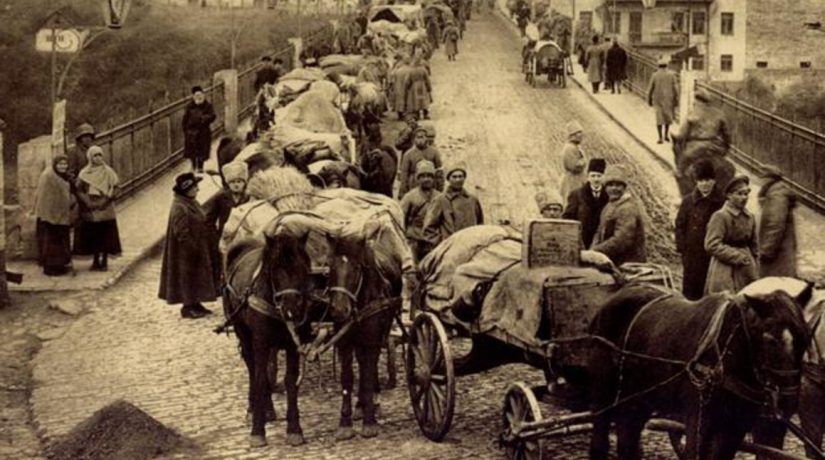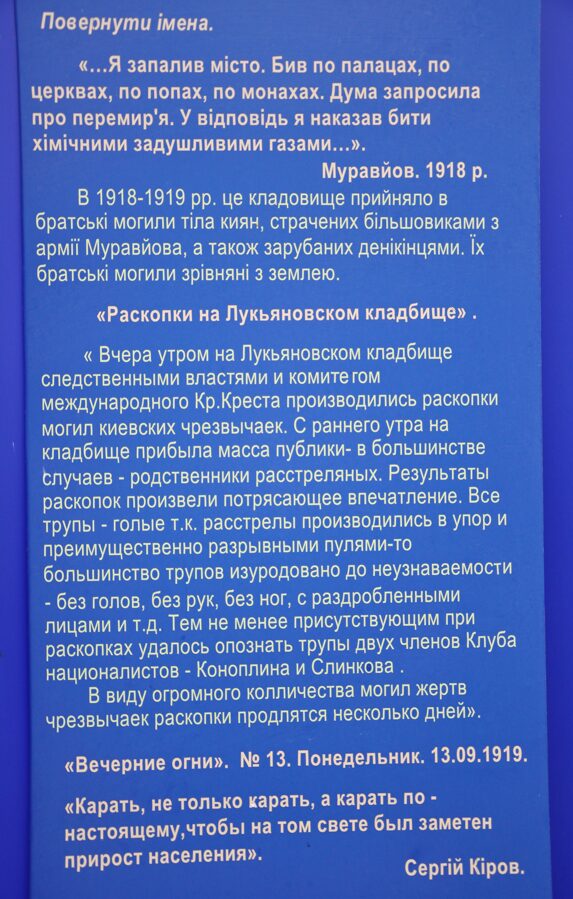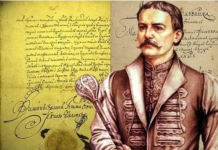Harvard Professor Richard Pipes in his 1997 revised edition of The Formation of the Soviet Union: “The activities of the Ukrainian Rada [in 1917] made it clear that the Ukrainian nationalists would not continue the policy of sympathetic neutrality which they had adopted during October. Faced with the alternative of violating his program of national self-determination or damaging what he considered the best interests of the proletariat, Lenin without much hesitation chose the former course. Orders were issued to Soviet officers in charge of the recently seized Stavka to prepare for a campaign against the Don Cossacks and if necessary to take action against the forces of the [Ukrainian] Rada. The Red Commanders worked out a plan calling for the seizure of Kharkiv and Ekaterinoslav [Dnipro] in the east, and diversionary attacks on Kyiv from the north (Chernihivv) and west (Podollia).”
Comment. Just a couple of days before the full-scale invasion in February of 2022, in his televised speech Putin made yet another attempt to present Ukraine as a recent creation by declaring that “Soviet Ukraine is the result of the Bolsheviks’ policy and can be rightfully called ‘Vladimir Lenin’s Ukraine”. The quote from the book above can be used to debunk the silly statement. Dr. Pipes provides even deeper insight into the ‘Ukrainian question’ within the Russian Bolshevik leadership: “Piatakov, the actual boss of the Bolshevik party of the southwestern region centered in Kyiv, who even before the Revolution had been known as an opponent of the temporary alliance with nationalism advocated by Lenin, stated bluntly the attitude of the local Bolsheviks in 1917: On the whole we must not support the Ukrainians, because their movement is not convenient for the proletariat. Russia cannot exist without the Ukrainian sugar industry, and the same can be said in regard to coal (Donbass), cereals (the black-earth belt), etc… We have before us two tasks: to protest against the measures of the government, and especially those of Kerensky, on the one hand, and to fight against the chauvinistic strivings of the Ukrainians on the other.”
“At the beginning of December [1917], Zinoviev arrived in Kyiv for talks; a week later a delegation of pro-Bolshevik Ukrainian peasant representatives came there for the same purpose. But all attempts at a peaceful solution of the impending conflict failed, and it is difficult to see how it could have been otherwise, since nothing short of an actual surrender of all sovereign rights on the part of the General Secretariat would have satisfied the Bolshevik demands. While these discussions were still in progress, the Bolshevik press began to lay down a heavy barrage of invective and threats against the Rada… On January 4/17, 1918, the Kharkiv Bolsheviks proclaimed the Rada “an enemy of the people” and the next day a number of detachments of Antonov-Ovseenko’s command left Kharkiv in the direction of Poltava: They consisted of units of so-called “Red Cossacks,” organized by the Kharkiv government of pro-Communist Ukrainians; of a Red Guard, formed in Kharkiv of various local elements, with criminal groups predominating; and finally of a hard core of Russian workers, soldiers, and sailors sent from the north, who composed the bulk of the invading force. The over-all command of this motley army was entrusted to Lieutenant Colonel Muraviev, an ex-officer of the Tsarist Army of Left SR sympathies whom Antonov-Ovseenko had appointed a member of his staff. The entire group consisted of 600 to 800 men, but its battle strength was greater, for it was preceded by Bolshevik agents dispatched from Kharkiv to organize fifth columns in the regions lying on the path of the army. Muraviev, whose ultimate destination was Kyiv, took a route leading across the southern fringes of the Chernihiv province, where the Bolsheviks had considerable party following in the railroad towns. The march on Poltava presented no difficulties. Only on the very outskirts of the city were the Soviet forces met by small detachments of Ukrainian troops, but those were easily dispersed…
(Note. Professor probably forgot about the Battle of Kruty that took place some 130km northeast of Kyiv. In it, a small Ukrainian unit of 400 soldiers of which 300 were students fought Muraviev’s forces and inflicted serious losses on the Russians. Ukrainian-Canadian historian Orest Subtelny described it in the following words: “… not far to the east at Kruty, Petliura’s men made their last major stand against Muraviev’s advancing forces. After several days of intense fighting, the Ukrainians were forced to retreat. In the process, a unit of 300 schoolboys was surrounded, and, after fierce resistance, slaughtered. Their deaths earned for them a place of honor in the Ukrainian national pantheon“).
Muraviev lost no time in informing the local citizens of his mission:
“Citizens! The Civil War has started. The Civil War goes on. From the Baltic to the Black Sea across the Danube towards Vienna, Berlin, Paris, and London we shall march with fire and sword, establishing everywhere Soviet power. With fire and sword we shall destroy everything which will dare to stand on our way. There will be no mercy for any of our enemies.”
To instill further terror, the Bolshevik Commander issued proclamations reporting fictitious executions of nonexistent people, and dispersed the Poltava Soviet’s numerous Socialist Revolutionary and Menshevik members, replacing them with his own soldiers. The Red troops in the captured town went on a wild orgy, which Muraviev himself described as a “drunken bacchanalia”.
The storming of Kyiv took place during the ongoing peace negotiations at Brest-Litovsk on 5–8 February 1918. The Russian forces approached Kyiv from the eastern direction towards the central bridge across the Dnieper River. Muraviev recalled later: “We were going to establish Soviet power with fire and sword. I occupied the city and hit the palaces and churches. On January 28 Duma (Kyiv) asked for a truce. In response, I ordered them to be gassed. Hundreds of generals, and maybe thousands, were mercilessly killed … So we took revenge. We could stop the wrath of revenge, but we did not, because our slogan is to be merciless!” Standing on the left bank of the Dnieper River, the Reds shelled the city for several days firing at least 15,000 shells on the city. After that, Muravyov used poison gases that were prohibited by International Law. And only after that, the Russian Horde entered the city and started doing what it likes the best – killing defenseless and looting.
Dr. Richard Pipes again: “The Bolshevik government established in Ukraine in January 1918 was a failure. First of all, it was a regime founded on sheer military force without the active support or even the sympathy of the Ukrainian people. Muraviev, in his dispatch to Lenin reporting the capture of Kyiv, frankly referred to the regime as one “established by means of bayonets.” To make matters worse, the behavior of the Red Army conquerors in Ukraine not only failed to win new adherents for the Soviet cause, but even alienated those groups of the population who at first were not averse to the reéstablishment of Russian rule. The invading army consisted largely of Russian industrial workers — who looked upon rough and ready methods of dealing with opposition, real and imaginary, as the best way of completing the “job” they had been assigned — and of criminal elements, enlisted in the so-called Red Guard, who took advantage of the war to pillage, loot, and murder at will. Discipline was extremely lax. The Red soldiers were frequently drunk, and organized pogroms against the local population which their commanders had no means of curbing. Nor did Muraviev himself help the situation. An unbalanced, sadistic megalomaniac, who, according to Antonov-Ovseenko, delighted in talking without end about “the flow of blood,” he issued orders to “annihilate without mercy all officers and junkers, haidamaks, monarchists, and all enemies of the revolution found in Kyiv.”

The Lukianivka/ Lukianivske cemetery is one of the oldest necropolises of Kyiv; it was founded in the early 1870s. Around 1900, it received the status of the Central cemetery where the prominent citizens of Kyiv were buried including the Ukrainian nobility, leading scientists, and prominent clergymen. The years 1918-1919 became a tragic period even for the cemetery when the hundreds of innocent victims of the armies commanded by Muraviev and Denikin were buried in the common graves.
The stand below at the entrance to the cemetery has the Muraviev’s quote mentioned in the text above. It is the top one in the picture below.”They begged for peace, but I ordered to shell and gas them”.
Next goes a quote from a 1919 Kyiv newspaper article:
Excavations at Lukianovske Cemetery
“Yesterday morning at Lukianivske cemetery, the investigative authorities and the committee of the international Red Cross excavated the graves of the victims of the Cheka [Bolshevik committee]. Since early morning a mass of people has arrived – in most cases – the relatives of the executed. The results of the excavations had a shocking effect. All corpses were naked, because the shootings were done at point-blank range and mainly with explosive bullets, the majority of corpses were mutilated beyond recognition – without heads, arms, legs, with fragmented faces, etc. Nevertheless, the people present at the excavation managed to recognize the corpses of two members of the Nationalists Club – Konoplin and Slinkov. Because of the huge number of Cheka graves, the excavations will last several days.
“Evening Lights”. No 13. Monday, 13. 09.1919
“Punish, not just punish, but punish indeed, so that in the other world the addition of population would be noticeable”. Sergei Kirov

Lenin created an ‘avatar’ of Ukraine after suppressing the true Ukrainian State >










